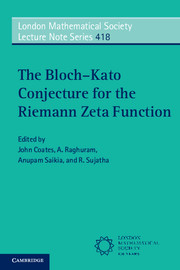Book contents
- Frontmatter
- Contents
- List of contributors
- Preface
- 1 Special Values of the Riemann Zeta Function: Some Results and Conjectures
- 2 K-theoretic Background
- 3 Values of the Riemann Zeta Function at the Odd Positive Integers and Iwasawa Theory
- 4 Explicit Reciprocity Law of Bloch–Kato and Exponential Maps
- 5 The Norm Residue Theorem and the Quillen-Lichtenbaum Conjecture
- 6 Regulators and Zeta-functions
- 7 Soulé's Theorem
- 8 Soulé's Regulator Map
- 9 On the Determinantal Approach to the Tamagawa Number Conjecture
- 10 Motivic Polylogarithm and Related Classes
- 11 The Comparison Theorem for the Soulé–Deligne Classes
- 12 Eisenstein Classes, Elliptic Soulé Elements and the ℓ-Adic Elliptic Polylogarithm
- 13 Postscript
- References
13 - Postscript
Published online by Cambridge University Press: 05 March 2015
- Frontmatter
- Contents
- List of contributors
- Preface
- 1 Special Values of the Riemann Zeta Function: Some Results and Conjectures
- 2 K-theoretic Background
- 3 Values of the Riemann Zeta Function at the Odd Positive Integers and Iwasawa Theory
- 4 Explicit Reciprocity Law of Bloch–Kato and Exponential Maps
- 5 The Norm Residue Theorem and the Quillen-Lichtenbaum Conjecture
- 6 Regulators and Zeta-functions
- 7 Soulé's Theorem
- 8 Soulé's Regulator Map
- 9 On the Determinantal Approach to the Tamagawa Number Conjecture
- 10 Motivic Polylogarithm and Related Classes
- 11 The Comparison Theorem for the Soulé–Deligne Classes
- 12 Eisenstein Classes, Elliptic Soulé Elements and the ℓ-Adic Elliptic Polylogarithm
- 13 Postscript
- References
Summary
Abstract
The aim of this postscript is to provide a Leitfaden between the articles in this volume and their interlinkages, thereby clearly delineating the results from Galois cohomology and K-theory that are used in proving the main results in [BK90]. One reason to do this is to explicitly spell out the K-theoretic results that are used in [BK90], especially those of Soulé. We shall also indicate a proof of the finiteness of the global Tate–Shafarevich groups as considered in [BK90, 5.13] for M = ℤ(m); and note its relation to the Tate–Shafarevich groups considered by Fontaine and Perrin-Riou [FP94], as well as the Tate–Shafarevich groups that can be defined from the Poitou–Tate sequence. For simplicity, we only consider the base field ℚ, indicating briey how the results generalize to an arbitrary totally real abelian number field. As in the previous articles, p will denote an odd prime. All other notation is as in [Su15]. Nguyen Quang Do's contribution in putting this note together is gratefully acknowledged.
Leitfaden
In the article [Li15], Lichtenbaum used K-theory and étale cohomology along with the Chern class maps to prove Soulé's result on the vanishing of the cohomology groups for all m ≥ 2. Soulé [So79] proved that these groups are torsion and Schneider [Sc75] proved that they are divisible. The Quillen–Lichtenbaum conjecture asserts that the Chern class maps
are isomorphisms for p odd, k = 1, 2 and m ≥ 2. Soulé in [So79, Théoréme 6 (iii)] proved the surjectivity for even positive integers m. Dwyer and Friedlander [DF85] proved it for all integers m with k = 1 or 2 or 2m − k > 1, using étale K-theory. The reader should also see [Ka93]. The vanishing of for all m ≥ 2 is equivalent to the finiteness of for m ≥ 2 and this will play an important role in the proof of the Bloch–Kato conjecture, as explained in the article by Coates [Co15] in this volume.
- Type
- Chapter
- Information
- The Bloch–Kato Conjecture for the Riemann Zeta Function , pp. 297 - 305Publisher: Cambridge University PressPrint publication year: 2015
References
- 1
- Cited by

